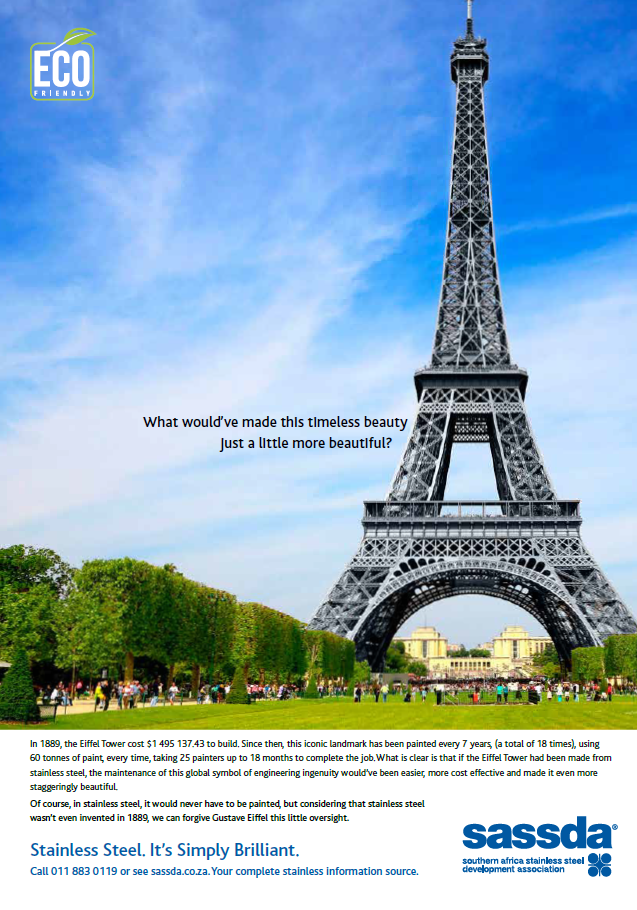 SASSDA’S LCC APP COMPETITOIN WILL SEND TWO LUCKY PEOPLE TO SEE THE EIFFEL TOWER IN PARIS
SASSDA’S LCC APP COMPETITOIN WILL SEND TWO LUCKY PEOPLE TO SEE THE EIFFEL TOWER IN PARIS
What could’ve made this timeless beauty just a little more beautiful?
In 1889, the Eiffel Tower cost $1 495 137.43 to build. Since then, this iconic landmark has been painted every 7 years, (a total of 17 times), using 50 tonnes of paint every time, taking 25 painters up to 18 months to complete the job. What is clear is that if the Eiffel Tower had been made from stainless steel, the maintenance of this global symbol of engineering ingenuity would have been easier, more costeffective and would’ve made it even
more staggeringly beautiful.
Of course, in stainless steel, it would never have to be painted, but considering that stainless steel wasn’t even invented in 1889, we can forgive Gustave Eiffel this little oversight.
THE LCC ADVANTAGE
One of the biggest obstacles to the specification of stainless steel in certain applications, is the ongoing misperception that it’s more expensive in comparison to other, initially cheaper options. In the short term, that may be the case considering upfront costs. However, its durability and ease of maintenance compensate for the sometimes-higher initial purchasing costs and it is often the least expensive choice in a life cycle cost comparison.
Its ability to provide long-term performance with a minimum of downtime and cost associated with maintenance is determined by calculating the material’s life cycle costing (LCC), which is of particular importance to the stainless steel industry. Life cycle costing is a technique developed for identifying and quantifying all costs, initial and ongoing, associated with a project or installation over a given period.
The technique uses the standard accountancy principle of discounted cash flow, so that total costs incurred during a life cycle period are reduced to present day values. This allows for a realistic comparison to be made of the options available. As far as material selection is concerned, LCC enables potential longterm benefits to be assessed against short-term expediency.
Materials costs are assessed with their related implications, such as: initial outlay; maintenance and its frequency; downtime effects and production losses; repair and replacement costs; and other operationally related costs such as manpower and energy consumption.
A WORLD FIRST APP
 To assist with the process of costing a project’s real cost, a world-first App from sassda is set to lift the lid on the bigger picture – namely stainless steel’s ability to ensure far lower overall life cycle costs.
To assist with the process of costing a project’s real cost, a world-first App from sassda is set to lift the lid on the bigger picture – namely stainless steel’s ability to ensure far lower overall life cycle costs.
The benefit of the newly launched App, which is now available from the Google Play Store for Android devices and from the Apple iStore, is that it allows for the almost real-time calculation of the LCC of stainless steel via an easy to use, pre-programmed calculator. This requires the entry of key top-line data, followed by the simple click of a “calculate” button, which in turn generates a breakdown of the relevant costs and has the ability to e-mail this to the relevant recipients.
The App was created to assist engineers to calculate the total LCC using the standard accountancy principle of discounted cash flow, so that total costs incurred during a life cycle period are reduced to present day values. This allows a realistic comparison to be made of the options available. In terms of material selection, the App also enables potential long-term benefits to be assessed against short-term expediency.
In this way sassda is hoping to educate the market on the inherent benefits of stainless steel which include minimal maintenance, at least a 60-year lifespan and significant environmental benefits.


